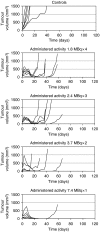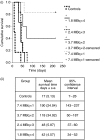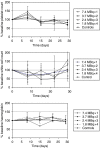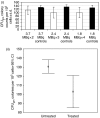Fractionated 131I anti-CEA radioimmunotherapy: effects on xenograft tumour growth and haematological toxicity in mice
- PMID: 18682714
- PMCID: PMC2527834
- DOI: 10.1038/sj.bjc.6604511
Fractionated 131I anti-CEA radioimmunotherapy: effects on xenograft tumour growth and haematological toxicity in mice
Abstract
Dose fractionation has been proposed as a method to improve the therapeutic ratio of radioimmunotherapy (RIT). This study compared a single administration of 7.4 MBq 131I-anti-CEA antibody given on day 1 with the same total activity given as fractionated treatment: 3.7 MBq (days 1 and 3), 2.4 MBq (days 1, 3, and 5) or 1.8 MBq (days 1, 3, 5, and 8). Studies in nude mice, bearing the human colorectal xenograft LS174T, showed that increasing the fractionation significantly reduced the efficacy of therapy. Fractionation was associated with a decrease in systemic toxicity as assessed by weight, but did not lead to any significant decrease in acute haematological toxicity. Similarly, no significant decrease in marrow toxicity, as assessed by colony-forming unit assays for granulocytes and macrophages (CFUgm), was seen. However, there was a significant depression of CFUgm counts when all treated animals were compared with untreated controls, suggesting that treatment did suppress marrow function. In conclusion, in this tumour model system, fractionated RIT causes less systemic toxicity, but is also less effective at treating tumours.
Figures






Similar articles
-
Improved treatment of medullary thyroid cancer in a nude mouse model by combined radioimmunochemotherapy: doxorubicin potentiates the therapeutic efficacy of radiolabeled antibodies in a radioresistant tumor type.Cancer Res. 1997 Dec 1;57(23):5309-19. Cancer Res. 1997. PMID: 9393755
-
Dosimetric evaluation and radioimmunotherapy of anti-tumour multivalent Fab' fragments.Br J Cancer. 1999 Nov;81(6):972-80. doi: 10.1038/sj.bjc.6690795. Br J Cancer. 1999. PMID: 10576653 Free PMC article.
-
Biokinetics of a F(ab')3 iodine-131 labeled antigen binding construct (Mab 35) directed against CEA in patients with colorectal carcinoma.Cancer Biother Radiopharm. 2001 Oct;16(5):371-9. doi: 10.1089/108497801753354276. Cancer Biother Radiopharm. 2001. PMID: 11776754
-
Adjuvant 131I-anti-CEA-antibody radioimmunotherapy inhibits the development of experimental colonic carcinoma liver metastases.Anticancer Res. 1998 Mar-Apr;18(2A):843-8. Anticancer Res. 1998. PMID: 9615730
-
Radioimmunotherapy of colorectal cancer liver metastases: combination with radiotherapy.Ann N Y Acad Sci. 2000 Jun;910:263-9; discussion 269-70. doi: 10.1111/j.1749-6632.2000.tb06714.x. Ann N Y Acad Sci. 2000. PMID: 10911919 Review.
Cited by
-
Antibody-cytokine fusion proteins: A novel class of biopharmaceuticals for the therapy of cancer and of chronic inflammation.N Biotechnol. 2019 Sep 25;52:42-53. doi: 10.1016/j.nbt.2019.04.002. Epub 2019 Apr 13. N Biotechnol. 2019. PMID: 30991144 Free PMC article. Review.
References
-
- Beaumier PL, Venkatesan P, Vanderheyden JL, Burgua WD, Kunz LL, Fritzberg AR, Abrams PG, Morgan ACJ (1991) 186Re radioimmunotherapy of small cell lung carcinoma xenografts in nude mice. Cancer Res 51: 676–681 - PubMed
-
- Bloechl S, Beck R, Seidl C, Morgenstern A, Schwaiger M, Senekowitsch-Schmidtke R (2005a) Fractionated locoregional low-dose radioimmunotherapy improves survival in a mouse model of diffuse-type gastric cancer using a 213Bi-conjugated monoclonal antibody. Clin Cancer Res 11(19 Part 2): 7070s–7074s - PubMed
-
- Bloechl S, Beck R, Seidl C, Morgenstern A, Schwaiger M, Senekowitsch-Schmidtke R (2005b) Fractionated locoregional low-dose radioimmunotherapy improves survival in a mouse model of diffuse-type gastric cancer using a 213Bi-conjugated monoclonal antibody. Clin Cancer Res 11(19 Part 2): 7070s–7074s - PubMed
-
- Blumenthal RD, Kashi R, Sharkey RM, Goldenberg DM (1995) Quantitative and qualitative effects of experimental radioimmunotherapy on tumor vascular permeability. Int J Cancer 61: 557–566 - PubMed
Publication types
MeSH terms
Substances
Grants and funding
LinkOut - more resources
Full Text Sources
Medical

